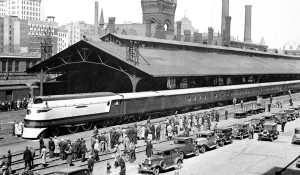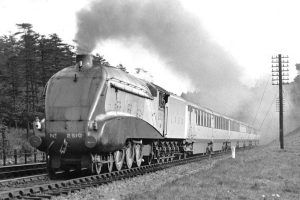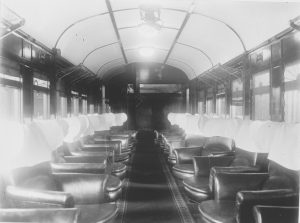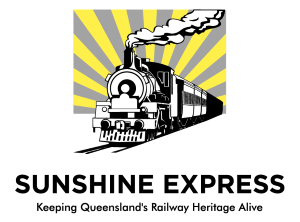History of the Sunshine Express Name
In the early years of Federation, two great railways were being built simultaneously across the far corners of the nation. One was the Commonwealth’s Trans-Australian Railway running East-West and the other was Queensland’s North Coast Line. Both advanced Australia along the path of nationhood.
In their time they were Australia’s longest individual railway projects, each stretching for more than 1000 miles and upon completion they differed by only eight miles in length. Both were begun by pick and shovel.
The Trans-Australian Railway, the first great construction work of Federation thrust across an arid landscape with not a single watercourse or settlement to sustain the men track-laying in the wilderness. To join east and west they laboured for five dry, dusty years while three governments – South Australia, Western Australia and the Commonwealth debated the merits of their work until the two sections of rail covering 1051 miles finally met among the lonely sand hills.
Building Queensland’s North Coast Line was an entirely different scenario. No empty Nullabor Plain but established ports and towns awaited the gradually extending track. Not desert but flooding rivers and green jungle along with snakes, mosquitoes and sometimes crocodiles challenged engineers and navvies alike. The rail was the medium gauge at 3’ 6”, precisely what a colony of immense distances and scattered population was able to afford. Any money for the project came from Queensland’s own pocket or rather from the loans it negotiated.
A colourful and sometimes exotic workforce firstly of contractors and later of government day labour took 35 years of intermittent construction to complete the North Coast Line. Political fortunes ebbed and flowed as did State Treasury funds. The North Coast Railway Act of 1910 articulated a determination to develop and populate the tropical north of the State and to attract visitors who might begin their journey from Adelaide, Melbourne or Sydney. When a cheering crowd welcomed the first train across the North Johnstone River in 1924 it marked the final link in the 1043 miles of rail that stretched from Brisbane to Cairns by far the longest main line of any Australian state – the Sunshine Route.
Completion of the Trans-Australian Railway in 1917 and the North Coast Line in 1924 was the climax of the nation’s grand railway schemes until gauge standardization and the north-south line to Darwin some four decades later. The Trans-Australian and North Coast Lines showed what could be done with political will, money and engineering prowess. Both fulfilled their promise. Both continue to serve the nation.
Ten years after cutting the ribbon on the North Johnstone (Daradgee) Bridge the final link in the North Coast Line, Australia found itself enmeshed in a worldwide depression and for the State of Queensland, there was nothing much to celebrate. But the hard times eventually sparked a Government program to spend its way back to prosperity through a series of public works of which the railways were part. Out of the gloom came a plan for Queenslanders to build a luxury train that would lift the pride and spirit of the populace and draw business to the North. So began the journey of the Sunshine Express.
Around the World 1935 was a great year for speed. On its maiden voyage the new French luxury liner “Normandie” proved to be the greyhound of the trans-Atlantic trade. In sunny California in the United States a young aeronautical engineer named Donald Douglas completed the transformation of his pioneer airliner into the Douglas Commercial 3. It was larger, faster and more comfortable than its predecessors. American Airlines ordered 20 before the first DC3 rib was even cut.
 On the rails it was a year of streamlined shapes and steam. In America the Milwaukee Railroad launched the sleek Hiawatha hauled by magnificent Atlantic (4-4-2) locomotives with 7ft driving wheels. Each day the Hiawatha raced the 412 miles between Chicago and the Twin Cities of Minneapolis and St. Paul at speeds in excess of 100 mph and with 500 tons in tow.
On the rails it was a year of streamlined shapes and steam. In America the Milwaukee Railroad launched the sleek Hiawatha hauled by magnificent Atlantic (4-4-2) locomotives with 7ft driving wheels. Each day the Hiawatha raced the 412 miles between Chicago and the Twin Cities of Minneapolis and St. Paul at speeds in excess of 100 mph and with 500 tons in tow.
In Britain the home of steam locomotion Sir Nigel Gresley’s wedge-shaped A4 Pacific named Silver Link reached 112½ mph on the London and North Eastern Railway. The trial on 27 September was a prelude to the engine entering service with the crack Silver Jubilee train which crossed the 268 miles between London and Newcastle in four hours.
These fast timings on standard gauge were echoed by equally impressive medium-gauge¹ records. Indonesia then the Dutch East Indies claimed the world’s fastest medium-gauge service between the cities of Batavia (Djakarta) and Surabaya where four-cylinder compound engines reputedly achieved 75mph over a distance of 512 miles. Japan also had its super-express the Tsubame (Swallow). It covered the 370 miles between Tokyo, Osaka and Kobe behind a handsome C51 class Pacific locomotive with a 14½ ton axle load. In 1935 the service was reduced to less than nine hours.
South Africa’s premier steam roster belonged to the Union Limited which spanned the 956 miles between Cape Town and Johannesburg in a journey of some 30 hours. Into this world of speed and steam Queensland’s Sunshine Express was launched on 27 May with a top speed of 40mph, someway short of its global counterparts.
Two Scotsmen had influential roles in making the Sunshine Express a reality. Their expertise lay in money and mechanics. One was William Forgan Smith the Premier of Queensland and the other was Robert J. Chalmers, Chief Mechanical Engineer of the Queensland Railways. Both came from Glasgow.
Decisive and a superb political tactician Forgan Smith was the undisputed leader of the Labor Party in Queensland. He led a government that invested in rail as part of its program to lead post-Depression Queensland toward better times. ‘Bobby’ Chalmers, sometimes fiery tongued, impulsive and impatient guided the mechanical fortunes of the Queensland Railways for 14 years. At Ipswich he was a respected engineer and undisputed chief of the workshops he ruled.
Queensland did not escape the worldwide depression of 1929-1932 which bled prosperity from every corner of society. For four years the Ipswich Rail Workshops had been starved of new construction programs. Tradesmen worked part-time or on reduced rates and senior men like Chalmers faced a salary reduction.
In 1932 State elections returned the Labor Party to government with a program of using budget deficits to lead Queensland towards prosperity. As the new Premier Forgan Smith began his cautious scheme of economic reconstruction to revive activity across all arms of the public service, and from this the railways gained its new North Coast mail train the Sunshine Express.
In the restrained language of his 1933-34 Annual Report Rail Commissioner James W. Davidson (1918-1938) announced:
The increasing passenger traffic by the Sunshine Route has made it desirable to proceed with the construction of three new up-to-date trains for that service and it is anticipated that the first of these will be placed in traffic about the end of March, 1935.
The work, which is being carried out in the Ipswich Workshops, comprises the construction of –
• Nine first-class sleeping cars (each with seven 2-berth cabins).
• Nine second-class sleeping cars (each with eight 3-berth cabins).
• Three first-class sitting cars.
• Three second-class sitting cars.
• Three parlour cars.
• Two dining cars.
 At Ipswich work had already begun quietly on planning a train intended to be the most modern and comfortable that Australian travelers would know. The title Sunshine Express had appeared in the October 1934 timetable as a publicity label for an extension of the Townsville Mail through to Cairns. The name sprang from a realization that a nation emerging from bitter times would surely want the freedom to travel. Queensland more than any other Australian State had the potential of sun, sea and scenery to lure the tourists north and what better way than by train?
At Ipswich work had already begun quietly on planning a train intended to be the most modern and comfortable that Australian travelers would know. The title Sunshine Express had appeared in the October 1934 timetable as a publicity label for an extension of the Townsville Mail through to Cairns. The name sprang from a realization that a nation emerging from bitter times would surely want the freedom to travel. Queensland more than any other Australian State had the potential of sun, sea and scenery to lure the tourists north and what better way than by train?
Medium-Gauge it might be and limited to a speed of 40 miles per hour but this would not deter Ipswich Workshops staff from devising a train that promised carefree relaxation on a journey of more than 1000 miles. It was by far the longest distance that any rail passenger could ride within one State border and as far as medium-gauge travel was concerned among the longest in the world.
As Chief Mechanical Engineer, Chalmers headed the new mail train project. To execute the design he appointed the head of the Drawing Office Charlie Hunt as leader of a team that included Senior Designing Mechanical Engineer Frank Downs and Bill Hall and Stan Kruger a young first grade draftsman. Kruger was raised to act in a higher grade position so that he could exercise his talent for innovation. In the years ahead, many at Ipswich would say that the Sunshine Express was really ‘Kruger’s train’.
The plan called for a train of sleek and uniform appearance, essentially ‘Queensland’ in the choice of timber-bodied coaches built on steel underframes. All coaches would measure a standard 52ft 6in long and 9ft wide (with the exception of the 55 ft 6in parlour cars) and allowing for Queensland’s generous loading gauge for rollingstock construction it would have semi-elliptical roofs to accentuate the interior space. (Material used for lining the carriage ceilings soon earned the train the title of ‘the plywood express’ among the Ipswich workers.)
Knowing that Queensland’s limited locomotive power needed all the help it could get roller bearing bogies were adopted throughout making it the first complete train in Australia to be equipped like this. In the carriage ‘shops’ an almost ‘production line’ assembly began of the 29 coaches necessary to form three mail trains for the Brisbane-Townsville-Cairns weekly schedule. Veteran carriage builders Foreman Alf Wallis and Sub-foreman Joe Tunstal were in charge of the more than 20 craftsmen of the No. 1 Gang assignee to the construction.
 Each train would consist of 12 coaches positioned behind the locomotive in the following order – brake van, baggage van, second class sitting car, First Class sitting car, three second class sleeping cars, dining car, three First Class sleeping cars and a palour-observation car.
Each train would consist of 12 coaches positioned behind the locomotive in the following order – brake van, baggage van, second class sitting car, First Class sitting car, three second class sleeping cars, dining car, three First Class sleeping cars and a palour-observation car.
In all, they provided accommodation for 206 passengers plus train crew. Insulation against the extremes of a northern climate received careful attention with the adoption of Colotex compressed sheeting in the roof to repel heat. Likewise, beneath the floor a rubber underlay muffled track noise in an era before welded rail. The coaches were also richly carpeted throughout. Records of the Ipswich Workshops show that to build a First Class sleeping car cost £5885/10/1. The cost of a parlour car was £4553/11/10. A First Class sitting car was £4299/17/6 and a second-class car was £4304/13/1.
 The exterior appearance of the Express drew much pleasing comment. Whereas passenger rollingstock had traditionally been painted in a maroon shade, for the Sunshine Express the choice was varnished natural cedar to convey the tropical spirit. Natural timbers were also a theme repeated throughout the interiors. Polished red cedar with matching red chrome leather upholstered seats in the twin-berth cabins of the First Class sleeping cars and varnished native pine in the three-berth second class cabins with matching red fabric upholstery. Red cedar paneling also featured in the dining car where by wide windows chairs of red chrome leather awaited the 29 patrons seated at tables arranged for two or four guests. The menu offered them lunch or dinner at 2/6 a head and morning or afternoon tea at 6 d each.
The exterior appearance of the Express drew much pleasing comment. Whereas passenger rollingstock had traditionally been painted in a maroon shade, for the Sunshine Express the choice was varnished natural cedar to convey the tropical spirit. Natural timbers were also a theme repeated throughout the interiors. Polished red cedar with matching red chrome leather upholstered seats in the twin-berth cabins of the First Class sleeping cars and varnished native pine in the three-berth second class cabins with matching red fabric upholstery. Red cedar paneling also featured in the dining car where by wide windows chairs of red chrome leather awaited the 29 patrons seated at tables arranged for two or four guests. The menu offered them lunch or dinner at 2/6 a head and morning or afternoon tea at 6 d each.
 Swiveling arm chairs again upholstered in red chrome leather were arranged in the trailing parlour car where the First-Class passengers could yarn, read a book, play cards or maybe summon the conductor for a pot of tea and nibbles from the kitchenette. Depending on the rollingstock employed they could also enjoy the passing scenery through the wide, glazed end of the car or be seated outside on an observation platform – Very American style!
Swiveling arm chairs again upholstered in red chrome leather were arranged in the trailing parlour car where the First-Class passengers could yarn, read a book, play cards or maybe summon the conductor for a pot of tea and nibbles from the kitchenette. Depending on the rollingstock employed they could also enjoy the passing scenery through the wide, glazed end of the car or be seated outside on an observation platform – Very American style!
On a train that travelled for almost two days into the tropics cooling had been a major question. The answer – or perhaps the compromise was a series of oscillating electric fans fitted to each cabin and sitting compartment supplemented by roof-top ventilators. Iced water was freely available (and hot water flasks for the First Class). Mirrors, arm rests, wardrobes and reading lights and ‘thoughtfully arranged’ bathrooms and lavatories were all part of a luxury train of which Queenslanders could be proud. But the fact remained that air-conditioning was one nicety that Sunshine Express passengers would go without.
Commissioner Davidson had carefully considered the air-conditioning option but ruled it was not for the Queensland Railways. The cost of installing the apparatus he wrote in his 1934-35 Annual Report would probably be nearer £3000 per carriage which in the case of the new trains being constructed for the Sunshine Route would mean an increase in their cost of about 50 per cent.
I am of the opinion that such an outlay is not justified. If the sum of £30,000 were available, I would prefer to improve the comfort of a large number of our older carriages … rather than that a few [passengers] should benefit by the air-conditioning of one train only. The experience of other railways, both abroad and at home, will be closely followed so that further consideration may be given to the matter…
 On Thursday 24 May 1935 the Hon. John Dash, the appropriately named Minister for Transport and Commissioner Davidson hosted an exhibition run of the first Sunshine Express from Brisbane to Landsborough on the North Coast Line. Proud to show off the design and workmanship of his Ipswich men an affable Bobby Chalmers strolled along the corridors fielding questions and sampling the comments of the politicians, judiciary, businessmen and reporters who were the invited guests. Numerous travelers admired the rattle-free rimless windows. The windows were a particular pride of the Chief Mechanical Engineer. He liked the wide view they braced and the security of quarter-inch plate glass yet when one of his draftsmen had suggested etching a motif into the glass to alert passengers when a window was closed, Bobby Chalmers was reported to have replied ‘only a bloody fool would try to stick his head through a pane of thick glass!’
On Thursday 24 May 1935 the Hon. John Dash, the appropriately named Minister for Transport and Commissioner Davidson hosted an exhibition run of the first Sunshine Express from Brisbane to Landsborough on the North Coast Line. Proud to show off the design and workmanship of his Ipswich men an affable Bobby Chalmers strolled along the corridors fielding questions and sampling the comments of the politicians, judiciary, businessmen and reporters who were the invited guests. Numerous travelers admired the rattle-free rimless windows. The windows were a particular pride of the Chief Mechanical Engineer. He liked the wide view they braced and the security of quarter-inch plate glass yet when one of his draftsmen had suggested etching a motif into the glass to alert passengers when a window was closed, Bobby Chalmers was reported to have replied ‘only a bloody fool would try to stick his head through a pane of thick glass!’
The Express returned from the VIP excursion late in the afternoon to be readied for the first run to Cairns in a few days’ time. Mr Chalmers unfortunately wasn’t aboard to receive the congratulations when they pulled into Central Station. During the journey the train had stopped at a signal for a seemingly undue amount of time. Impatient to investigate the delay the Chief Mechanical Engineer rose quickly from his seat to gaze along the track. Whack! Skin and skull collided with immovable glass that shattered into razor-sharp pieces. Forehead badly cut, blood flowing down his face, light concussion ensuing Bobby Chalmers was hurried to a casualty ward. A rapid order was sent to the Workshops. When the Sunshine Express left for Cairns three days later a dainty emblem was visible on every window.
The happy days of “Chasing the Sunshine” came to an abrupt end in 1942 in the aftermath of the Pearl Harbour attack and the rapid Japanese advance through the south-west Pacific to New Guinea and nearby Islands. Normal railway services suffered as Queensland Railways directed their attention to the war effort. American and Australian serviceman filled the compartments of the Sunshine Route not as tourists but personnel moving towards training camps and the jungle battle grounds. Priority traffic on the North Coast Line were trains filled with reinforcements and their weapons and supplies. Sleeping and Parlour cars were removed from the Sunshine Express and sent to the workshops to be rebuilt as hospital trains.
Peace returned to the Pacific after the Japanese surrender in 1945 but tourism struggled to resurrect itself in a decade pestered with dislocation and shortages. As life in the north slowly returned to normal the Sunshine Express resumed catering for long-distance travelers and the tourist trade. As a mail train the Sunshine service had never in fact ceased but now with the parlour cars missing and the over age rollingstock now painted red across the varnished timbers the luxury spirit was never quite recaptured.
For Railways worldwide the turning point to efficiency came with Diesel Electric traction. The Sunshine Express made its last run in 1953 but the North Coast Line began to swing back the pendulum of popularity with the introduction of an all new, all steel, Air-Conditioned sitting and sleeping train known as the Sunlander.
More than a century on after the passing of the North Coast Railway Act the route to the tropics carries traffic undreamed of when the first Sunshine Express steamed away. Travellers enjoy the option of one of Australia’s fastest service by comfortable tilt trains either electric or diesel powered or onboard the modern “Spirit of Queensland”, all in the Queensland Rail tradition of the Sunshine Route.
 The Australian Railway Historical Society – Queensland Division are proud to operate our Tours under the Sunshine Express banner as a tribute to the incredible engineering feat which is the North Coast Line and the pride and craftmanship that went into the construction of the Sunshine Express Train. We will continue to offer our passengers the opportunity to take a trip back in time to when rail travel was more about the journey than the destination.
The Australian Railway Historical Society – Queensland Division are proud to operate our Tours under the Sunshine Express banner as a tribute to the incredible engineering feat which is the North Coast Line and the pride and craftmanship that went into the construction of the Sunshine Express Train. We will continue to offer our passengers the opportunity to take a trip back in time to when rail travel was more about the journey than the destination.
We look forward to seeing you onboard one of our tours soon….
¹ Although the rail gauge in QLD is often referred to as Narrow Gauge we have chosen to use the term Medium-Gauge reflecting its 3’ 6” width. This distinguishes the Queensland mainline from the thousands of kms of true narrow gauge being 2’ and 2’ 6” in width.
Credit: Information about the Sunshine Express courtesy of the book “Chasing the Sunshine” by David Burke published by The Queensland Museum”

